
Drink-on-the-move for the Soldier
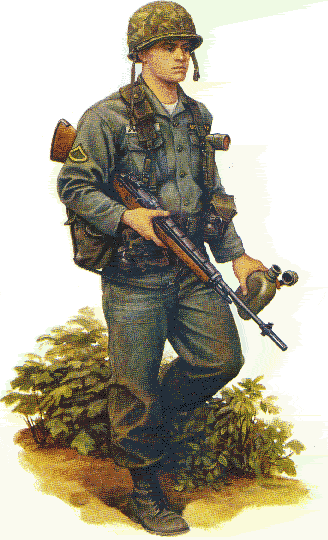
However, today we are still drinking from the same type canteens, using one hand! Is he ready to return fire? Imagine entire units drinking like this.
1st Tactical Studies Group (Airborne) Director Mike Sparks as a young marine had seen this "clusterfu*ck" of entire units stopping, taking a knee and facing weapons outboard just to take a drink from a canteen for 6 years when he decided in 1987 to do something about it. Friends in the Army side of the house at his college said at Special Forces selection some candidates took I.V. tubing and golf tees to hook up drink-on-the-move capabilities to stay moving.
Currently, you have to stop to get a drink from your G.I. one quart canteen, this tactical liability gets worse when entire squads, platoons and companies stop to drink water. When moving from point A to point B, over time each one of these stops reduces the speed of the ground force and exposes it to enemy observation and fire. But, if we can drink-while-on-the-move and not stop, our speed will increase. Such systems are vital to maximize the mobility potential of human powered vehicles (HPVs) like the All-Terrain "Mountain" Bike and Cart/Sleds or simply move faster on our feet--4-7 mph to outfight mountain , jungle and urban guerrillas who may hit you & run. We must be able to chase down that roadside bomber with a detonation device in his hand or RPG gunner so they cannot strike again.
The way to do this is with a drinking tube.
A simple drinking tube that plugs into the CAP of the G.I. canteen was demonstrated by the then USMC PLC Officer Candidate Sparks in 1987 to U.S. Army Natick labs via the marine liaison there. Sparks' idea was to cut costs by using a G.I. 2-quart canteen with a NBC cap inside the top flap of the ALICE rucksack connected by a schrade valve via a drink tubing so the Soldier would drink water in his rucksack first and then drop it like a fighter pilot drops external tanks when time to fight. This is still a good idea---you should drink water from your ruck "Existence Load" first so your "Fighting Load" stays full for the fight. All the military would have to buy would be the adapter and drink tube with a nylon sleeve on the rucksack or LBE shoulder strap with a velcro flap to secure the tube when not in use. We had contacted the maker of the M17A1 Field Protective Mask (FPM), Mine Safety Appliances and after a lot of convincing got them to supply a valve for the drink tube on the mask. And there it was! A fully functional drink-on-the-move system with NBC interface despite everyone saying it was too hard and expensive to do.
BEFORE THERE WAS MILITARY CAMEL-BAKS: RAIDER DRINKING TUBE
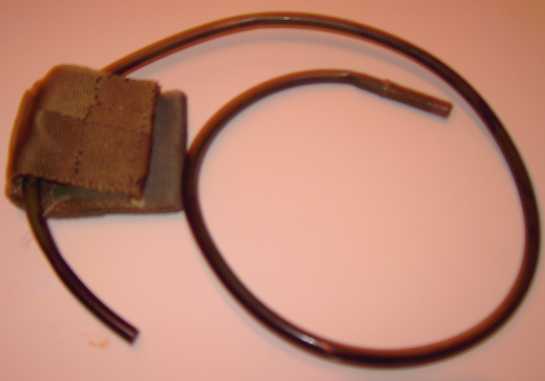
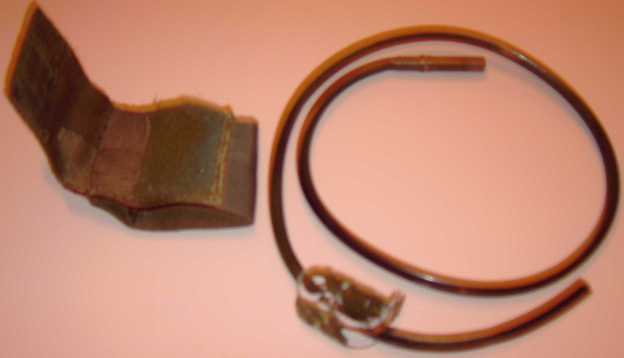
Attached to ALICE rucksack
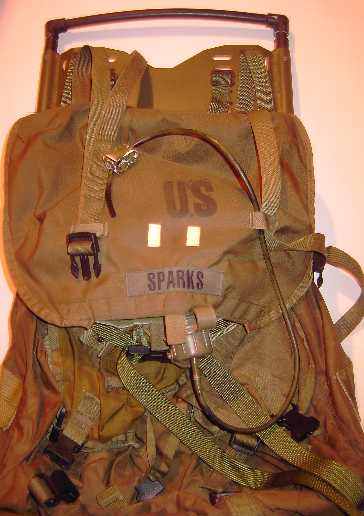
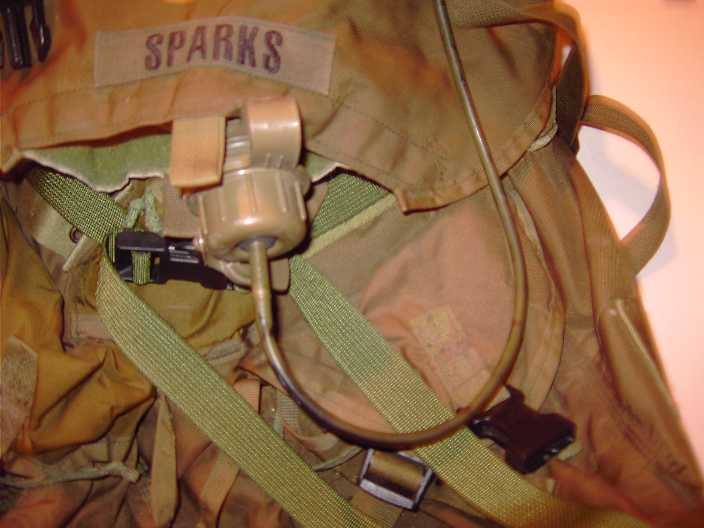
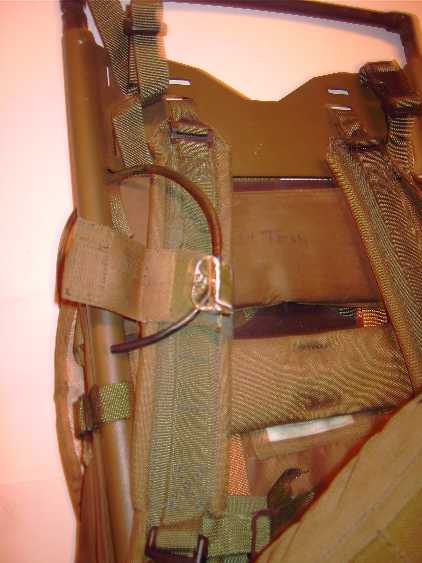
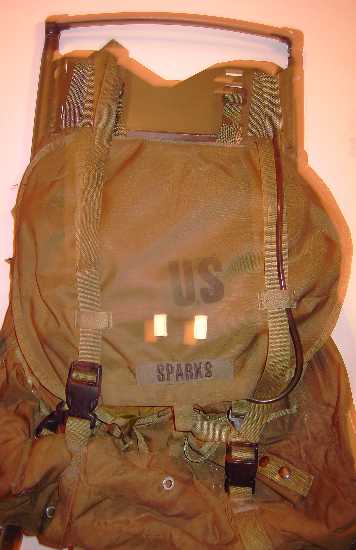
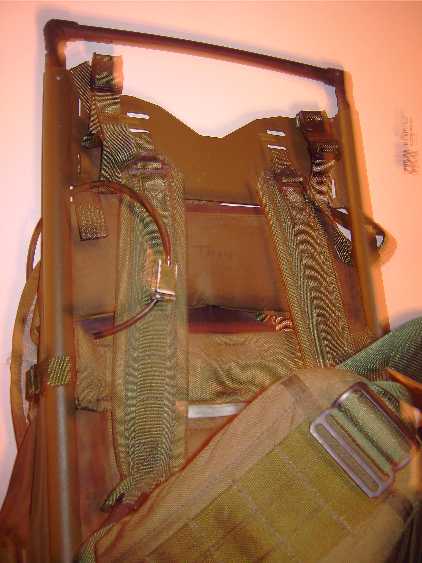
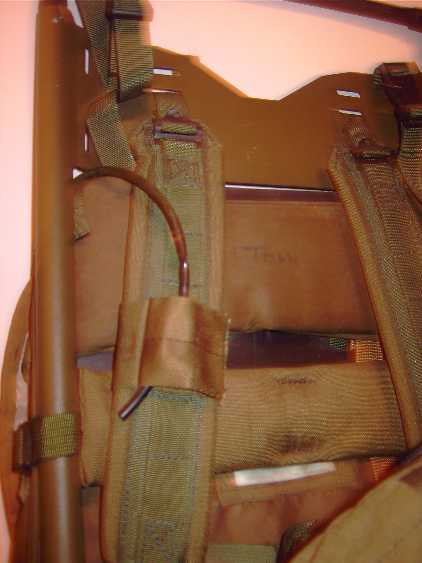
We (at the time the USMC Raider Club) field tested it hiking up and down the Blue Ridge mountains and it worked great! The letter below from retired Major General John Singlaub was for the Raider club sending in some help (they said they needed socks so we sent them socks) for Nicaraguan freedom fighters.
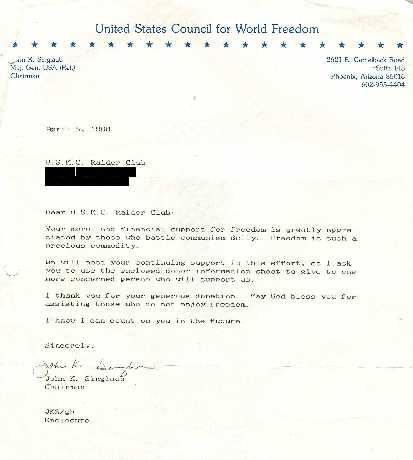
Sparks contacted USMC Liaison to Natick Labs and even drove up to the Washington D.C. area with his buddy and superb gear designer, Ron Schmitt of Loadmaster and made presentations of actual working prototypes of drink-on-the-move and an enhanced load bearing vest Ron had created to better distribute the Soldier's fighting load and get the rifle magazine pouches away from the legs.
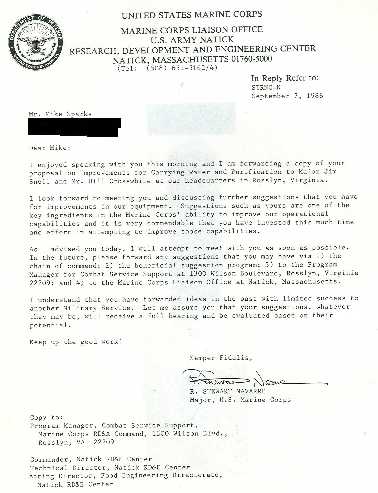
Their suggestions despite being based on actual working prototypes and given to the Army through USMC liaison endorsement for FREE were REJECTED!.
UPDATE 2006: USMC Liaison officer Navarre is now a Camp Pendleton, California Colonel and had his "15 minutes of fame" announcing that an investigation into a new marine massacre in Iraq (not the typical domestic marine murders like the recent Corporal who burned up a pregnant marine clerk Lance Cpl. Maria Lauterbach and their baby) was underway!

The bitter irony is that years later, drink-on-the-move with Camel-Bak® and ETLBV and MOLLE load bearing vests would be fielded throughout both the Army and USMC making all the flimsy excuses for rejecting our ideas years before suspect. We could have had better hydration and load bearing for our Soldiers 2 years before going to war in the Saudi/Iraqi deserts in 1990-1991 and the question is who and how many people paid for this with their lives? How many died from heat exhaustion/heat stroke? How many because they couldn't move fast enough to avoid enemy fire?
How the 1st Tactical Studies Group (Airborne) Began
From a near-death experience with hypothermia in frigid Fort McCoy, Wisconsin, in 1982 with the ill-equipped marines led then Lance Corporal Sparks on a quest for better gear. The British experience with breathable but rain-proof Gore-Tex in the Falklands war earlier that year showed there indeed was a better way. Armed with the latest Brigade Quartermasters and U.S. Cavalry Store catalogs, he begin a "market search" for the best gear out there to improve combat and field living capabilities. When gear existed he bought it and tested it; if it was good he wrote a suggestion proposal for the cheapskate USMC and U.S. Army to buy it. Below is the first thank-you, but go-to-hell-we-ain't-doing-anything-about-it-o-gram he received in 1983 from Natick Labs.
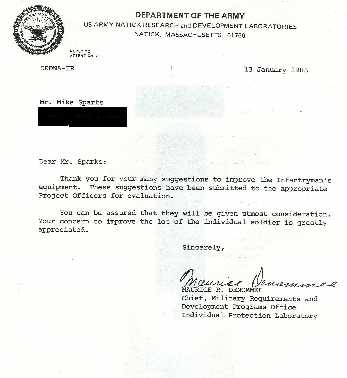
When the gear did not exist, he would create it himself or have his former USMCR reserve buddy Schmitt make it and then both test it out. Sometimes it was just modifying existing gear. Then Marine Corps Gazette would print his articles in their magazines as the monthly "Field Expedients" column. He also had gear suggestions printed in U.S. Army Infantry magazine's "Swap Shop" column. The USMC grass roots response was not of open-mindedness and experimentation but one of envy and hatred directed to Sparks for daring to say the marine corps had gear problems to solve. The USMC religion of Satan-Corps-Self had been attacked by mere constructive suggestions for improvement not even constructive criticism. This is way too much for the weak co-dependant marine ego, the messenger must be attacked so the message of truth smashing the ego house-of-cards cannot be received! Semper Back-Stab. Epluribus Fuck-You. Band of Back-Stabbers not Band of Brothers. "Who the hell was he?" and other personal attack egotisms was the constant cry. Unless you were a congressional medal of honor winner in a wheelchair with all your limbs shot off, you were "not worthy" to criticize the vaunted corps. Think of Mike Myers and Dana Carvey on their knees chanting this mantra in "Wayne's World" (see video clip below).
Forget about the laws of physics and FACTS that do not respect any person's social status. Mike had seen marines brutalized and killed by marine narcissistic egomaniac culture during recruit training and he wasn't and still doesn't wait until some mythical day when he will have "earned" enough rank and "respect" by kissing other people's asses and going along with their self-worship, to CALL-A-SPADE-A-SPADE---and call dangerous bullshit what it is--DANGEROUS BULLSHIT. Life is too short and death can strike in an instant if you are stupid; to institutionalize stupidity as the Army and marines do with their narcissistic existentialism is unacceptable and must be stopped. Physical planet earth reality does NOT revolve around the weak military ego. The constant cry from the slacker marines were that "we don't need any high speed gear" or survival training (ask LCPL Jason Rother's family if abandoning him in the 29 Palms desert in 1988 where he died from a lack of SERE training was AOK?), "we are MARINES" and other narcissistic hubris fails miserably in the face of physical reality where marines die because what they were doing was and is stupid. For example, when Sparks went through USMC boot camp in 1981, absurd WATER RATIONING policies were still in effect. Never mind, that this was a good 8 years after the Israeli's showed us in the Yom Kippur war that one of their secrets over the Arabs was to push water into their troops because medical studies had proved you cannot ration water from the human body. By the time your body shows thirst, YOU ARE ALREADY DEHYDRATED! Never mind, that Sparks was learning in his sports physiology classes and after school wrestling sessions in college that the best way to sustain athletic performance was to sip water over time and not guzzle an entire quart once in awhile. Macho egotism and stupidity and tragedy go hand-in-hand like homos and AIDS.
The sad truth is that the only way the arrogant U.S. military changes is after a bunch of people die needlessly. It takes HUMILITY to be pro-active and anticipate problems and then solve them. There is no humility in PRIDE and if there is to be HONOR there must first be HUMILITY. There is none of this in the all-volunteer U.S. military which attracts weak economic and ego co-dependents into the ranks. We didn't learn that military existentialism is a common disease of military incompetence until years later after we discovered Dr. Norman Dixon's book on the subject. There is no limit to the amount of bullshit people will embrace if their weak egos depend on a "mother" organization to trickle them drops of peer esteem when they should have had all along SELF esteem based on the fact of their individual uniqueness as human beings. Mike still remembers running around San Diego MCRD with a 1-quart canteen in his hand and then giving it to a drill instructor to pour over a recruit in heat stroke convulsions. He died later that night we were told. Several years later, Lance Corporal Jason Rother would pay for such attitudes with his life when he was abandoned by his chain of command in the 29 Palms desert after an exercise and did not have the survival skills or tools to walk his way out to rescue. At that time, marines did not wear nametapes on their uniforms and were easy to get lost in the shuffle to get out on weekend liberty to Las Vegas and other exciting nearby locations for wine, women and song.
In 1988, as a history major, Sparks was considering how to use fat-tire "mountain bikes" to create a new version of Light Bicycle Infantry (LBI) which had worked amazingly well in the past (British Cycle-Commandos, Yamashita in Singapore/Malaya etc.) upon a suggestion from his USMCR and college buddy, Jon Schweikart. Irritated by the Army's rejection of making their own drink-on-the-move equipment, he was ecstatic when he saw a "store bought" heat stroke/dehydration as well as tactical mobility enhancer in a bicycling catalog: a water bladder and drinking tube you wear on your back! The only problem was it came in flashy civilian colors and didn't have a NBC interface! He then contacted Roger Fawcett of FastTrak Systems in Texas [POB 1029 Weatherford, TX 76086, (817) 594-1000, FAX: -1030, (800) 767-8725] who was making the colorful drink systems for bikers and suggested he make his product in camouflaged military colors and eventually to get a FPM (gas mask) NBC interface. If you doubt this history, the following rather snide article nevertheless shows the reader that Fawcett truly was the first inventor of the Camel-Bak phenomena and that we are not making this all up.
ColostomyBak
First published April 1993
Using the stern-sounding slogan "Hydrate or Die," a Texas company is promoting the use of glorified colostomy bags as a space-age water bottle for outdoor sports. The CamelBak consists of a 2L plastic bladder with a long tube; the bladder slips inside an insulated carrying pouch and slings across your back. If you need a drink, you just bite down on a valve at the end of the tube and voilà, instant icewater, Gatorade, coffee, banana daiquiri, etc.
Designed as a convenient way to maintain hydration over long periods, the CamelBak caught on first with bicyclists, who find the handsfree system more convenient than reaching down for a water bottle. (CamelBak sales quintupled from 1991 to 1992, and by February 1993 sales had exceeded levels reached in all of 1992.) CamelBaks were used by U.S. troops in Operation Desert Storm (with a reflective mylar overlay), and in keeping with that tough-guy image, CamelBak maker FasTrak Systems offers a fabric overlay for the CamelBak in a camouflage motif.
The standard model, the ThermalBak, is complemented by the HalfBak, with a 0.95L capacity, and the IceBak, which lacks insulation on the inside surface, letting cold liquids cool you down or your body heat melt ice. Inventor Roger Fawcett receives many requests for a model with two compartments-- "so that they can carry vodka one side, tonic the other, know what I mean?"-- but hasn't come up with a workable prototype.
UPDATE: After living with the CamelBak for three years, I now could not cycle without it-- once you're accustomed to a certain level of hydration (i.e., the proper level), you can never go back. But the CamelBak has real defects:
The bite valve snags on things-- the strap of your backpack (particularly when removing the backpack), the side of the bin in which I toss the CamelBak after a ride, anything at all. This problem is worsened by the centrifugal force the valve develops when you whip the thing off your back. The bite valve can and will come off and bounce all over the ground, allowing water to pour all but nonstop all over your leg. Lay the CamelBak down on something-- anything-- and you can depend on the bite valve's finding its way into grit, dirt, or whatever detritus there is to get into. And where does the bite valve go when you're actually wearing the CamelBak? Why, yes, your mouth. How hygienic.
Size: The original CamelBak is quite large. I can't find a replacement bladder for my HalfBak and am not willing to shell out for a new one.
Disinfection: Very tricky. I have to clean mine every time I go out, usually with vinegar and baking soda (or use lemon juice and). Also dishwashing detergent works, but requires far more rinsing. Getting the bite valve clean and rinsed is still hit-and-miss after three years.
Redundancy: Backpacks really should include CamelBak sleeves by now. (One backpack from Mountainsmith does, but the other characteristics of the backpack drove me nuts.)
Looks: I am still self-conscious, after all this time, when removing my backpack (exposing you-know-what-- many bite-valve snags here) and walking around with the thing. (Hiding the tube and valve is difficult. Having it stick out from one's side is too reminiscent of a combo of nipple and erection.)
FasTrak Systems has invested a mint into expanding the CamelBak franchise with new variants. Perhaps Fawcett et al. ought to have perfected the main product first.
--------------------------------------------------------------------------------
Back to the Hyperopinionated Article List, or to the Joe Clark homepage.
Here's a more upbeat and less envious take on Camel-Bak:
www.startupjournal.com/columnists/ enterprise/20050720-karp.html
How a Water Pack Grew
From The Wall Street Journal Online
An avid cyclist living in the scorching heat of central Texas, Chuck Hunter staggered into a bike shop in 1997 and says he succumbed to a "cute" saleswoman's pitch. He left wearing a water-filled backpack with a tube extending to his mouth so that he could drink without reaching for a water bottle.
Two years after that first sip, Mr. Hunter quit his job at Lockheed Martin Corp. to join the company that made the backpack-canteen, CamelBak® Products LLC. At the time, the small firm had a devoted clientele of mountain bikers and counterculture types; for example, CamelBak®s were ubiquitous at Burning Man, a radical art festival held each summer in the Nevada desert.
Mr. Hunter, a former fighter pilot, sensed an emerging market among a different breed of desert dweller: the U.S. Soldier. Now CamelBak®'s senior vice president for government, military and industrial business, he has turned the Petaluma, Calif., company into a global leader in so-called hydration systems, selling several million backpacks to troops in the U.S. and some 50 foreign armies. The Pentagon, which recently placed a $17 million order so that it can issue CamelBak®s to all Soldiers heading to Iraq and Afghanistan, is the company's biggest customer.
That a cycling accessory could became the canteen of choice for Soldiers around the world demonstrates how innovative nondefense companies have fueled growth by capitalizing on the Sept. 11, 2001, attacks and the ensuing wars. Even before the London bombings this month, Britain had approved funds to equip police and first-responders with CamelBak® systems designed to keep drinking water safe in a chemical or biological attack. The U.S. Department of Homeland Security's new emphasis on unconventional threats heralds further growth potential for CamelBak®.
Other consumer products, such as Oakley Inc. sunglasses, Garmin Ltd. handheld global-positioning-system units and Under Armour clothing, have found fresh outlets in military sales. But military products have become CamelBak's dominant business. Instead of the "Hydration on the Move" motto geared to granola-eating fitness buffs, CamelBak®'s current slogan is "Hydrate or Die" -- emblazoned next to a flame-emitting skull.
CamelBak® contends that pivoting between the two markets has helped product development. "The beauty of this company is that military requirements drive innovation and durability, and that goes right down the line to the recreational products," says Mr. Hunter. For instance, CamelBak® developed sturdier materials and a silver-based, antigerm lining to keep water clean for troops, and then adapted these for cheaper retail packs. The company's products retail for between $25 and $120, and some military packs cost up to $200.
CamelBak® was founded in 1989 in Texas by Michael Eidson, who concocted a hands-free drinking system because he felt that reaching for a bottle during bike races risked collisions. The prototype consisted of medical tubing and a plastic intravenous drip bag stuffed into a sock and attached to the back of a shirt. His timing was auspicious: The advent of mountain biking, ultramarathons and other extreme sports created a market-in-waiting.
The 1991 Gulf War also helped. Navy SEALs and special-forces troops who were biking enthusiasts took their own CamelBak®s into combat. Word spread, as did CamelBak's civilian models on the shelves of military exchanges. In 1995, San Francisco firm Kransco, which had marketed Frisbees, Hula Hoops and Boogie Boards as a previous owner of Wham-O Inc., bought CamelBak for $4 million and stepped up military sales by introducing camouflaged models.
But the real military push started in 1999, when Mr. Hunter arrived. CamelBak® launched a military line of products and moved to California's Sonoma County wine district north of San Francisco. Here, it set up a research center to develop products that could meet the Pentagon's exacting standards.
As much as Soldiers liked the CamelBak® concept, early models tended to "burst when grunts fell backwards onto them," says CamelBak® R&D head Robert Choi. "It's harder to carry and deliver water than you'd think," he adds, walking through a lab where machines stretch, twist, squeeze and rapidly age polyurethane and silicone parts.
CamelBak®'s proprietary drinking nozzle, or bite valve, gets compressed 10,000 times to ensure it won't leak after three years of combat use. The company says it spent $1 million developing a reservoir liner to protect water in a sarin or mustard-gas attack. CamelBak® has received 70,000 orders for this "chem-bio" water reservoirs since its launch last September, Mr. Hunter says. Belgium ordered several thousand units and has mandated that new gas masks must be compatible with CamelBak tube adapters.
Feedback from Soldiers has been as important as lab tests in molding products. Snipers wanted a sleek, body-hugging pack, so CamelBak® designed a 3.2-quart unit -- enough for three hours of activity -- that can fit under bullet-proof vests.
For a different kind of stealth, CamelBak® worked with Dupont Co. and other companies to develop backpack material, straps and buckles that reduce infrared detection. CamelBak® markets some two dozen military models, carrying as little as 1.6 quarts of water and no gear to packs that can hold 6.3 quarts of water and seven times that volume in gear.
"Marines love them. Very rarely these days do you see a marine without a CamelBak® cinched to his back," says Col. Michael Belcher, who commanded a marine battalion in Iraq and is now based in the U.S. "There's less sloshing back and forth, and no hip pain."
Whereas Soldiers used to hook three one-quart canteens onto their belts, now they typically carry a 3.2-quart CamelBak® and one canteen -- which they might use only to refill the CamelBak®. CamelBak®s are part of the survival kits packed into ejection seats in many Air Force fighter planes.
In 2003, New York investment bank Bear Stearns Cos. bought CamelBak® for more than $200 million. Bear Stearns doesn't disclose CamelBak®'s sales and profit figures. With more than 90% of the U.S. military market and solid brand awareness among troops, "We're like Kleenex. Everyone calls a hydration system a CamelBak®," says product manager Shawn Cullen. The company's main military competitor is its biggest customer: The Army, working with a former canteen company, has fielded a similar hydration system.
CamelBak® has a host of challengers in the civilian market, such as VF Corp.'s JanSport and North Face brands, but is counting on its brand recognition, new recreational models and a thrust into products for industrial workers to keep growing.
After branching out from cycling into running, skiing and hiking packs, CamelBak® more recently has launched products for hunting, children and women -- a line that features tapered packs, softer materials and higher chest straps. Law-enforcement packs include easy-access pouches for weapons. A horseback-riding line is in the offing. Customers bombard the company with suggestions for packs designed to fight dehydration in every activity from fly fishing to plant watering. "Some uses could hurt the brand a bit," says Glenn Gross, CamelBak®'s chief executive.
Mr. Hunter's search for industrial customers has him pressing the flesh at events such as the World of Concrete trade show. But his work isn't done with the military. CamelBak® must ensure, he says, that "the canteen is on the way out."
OTHER ARTICLES BY THIS AUTHOR
Email your comments to sjeditor@dowjones.com.
www.joeclark.org/camelbak.html
by Joe Clark
To Be Soldiers' Essential
By JONATHAN KARP
Staff Reporter of The Wall Street Journal.
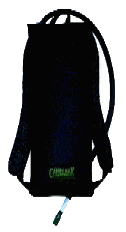
Despite a reasonable request for a Camel-Bak® in military colors, they were still being mass-produced in Black/Gray carriers. When you read down this web page we have a technique for camouflaging a "vanilla" Camel-Bak® into a suitable military color. The military Camel-Bak® was born sort of; in the beginning as a straight water-to-human drinking system via bite valve in a less than ideal black color.
So it took about another 10 years, but once U.S. Army Rangers were seen wearing Camel-Bak®s all of a sudden it became "cool", "acceptible" and now a "great idea" to our blind-obedient military with ego pecking orders. VOILA! Sales increase and finally Camel-Bak® offers them in decent military colors. About time! Camel-Bak®s are now all over the U.S. military!
1996: MSA TAKES A STAB AT THE PROBLEM...
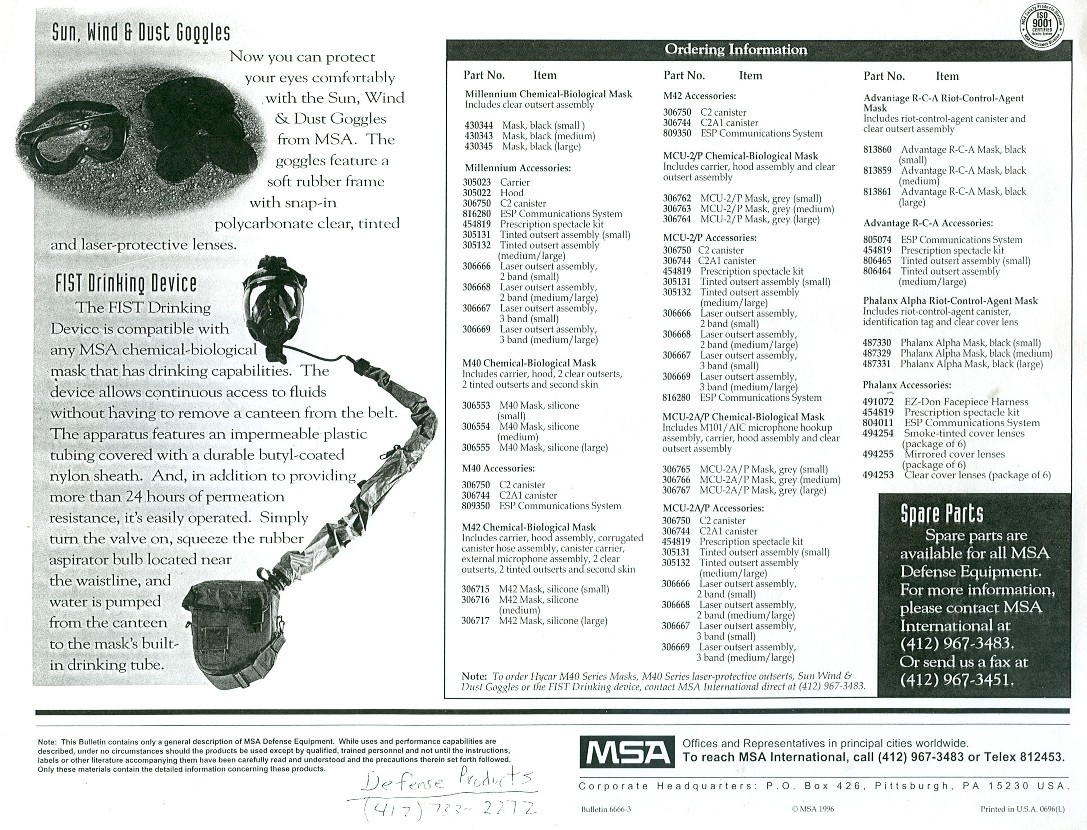
The first mass-produced solution for a regular G.I. canteen to field protective mask (FPM) drinking interface came from Mine Safety Appliances, maker of the M17, M40/M42 U.S. Military field protective masks. Their "FIST" drinking system is a long tube that connects to the G.I. canteen and the FPM, but offers no way to drink unless you are wearing the FPM. Never mind that MSA ignored Sparks when he brought up the idea years before...
1997: BATTELLE GETS INTO THE ACT...WHAT? I THOUGHT ALL THEY DID WAS RESEARCH?
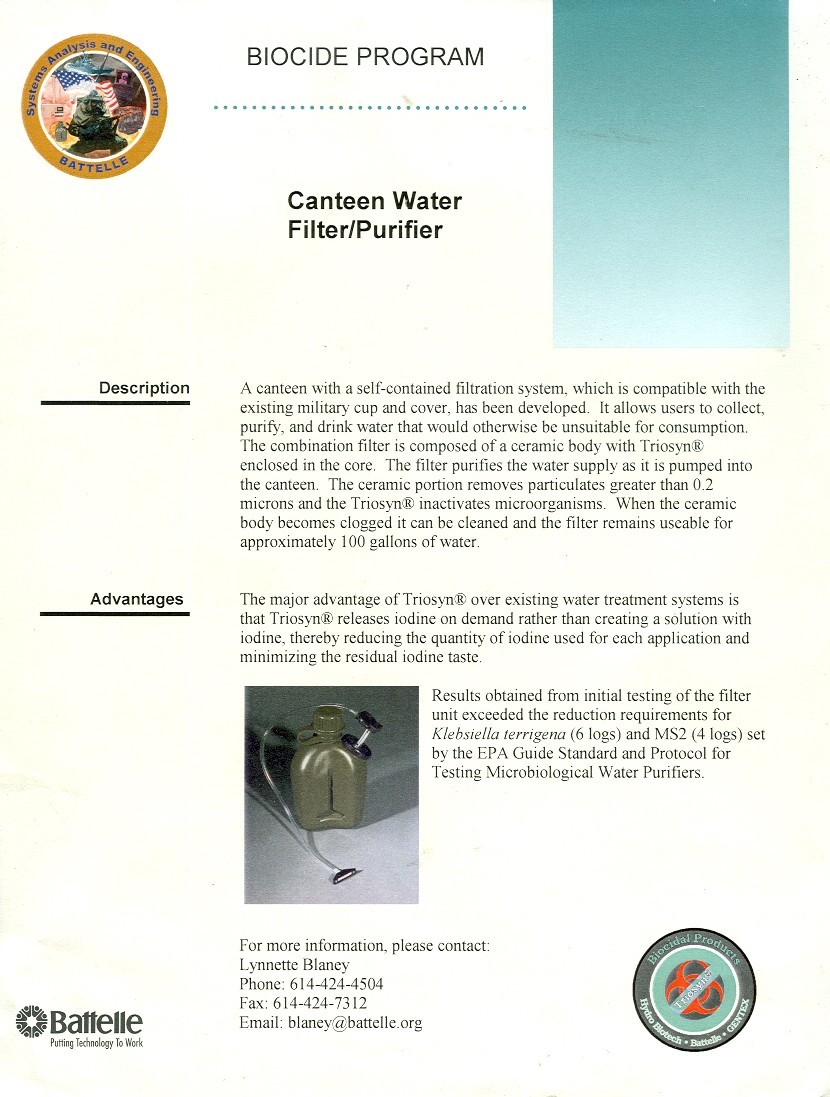
By 1997 even BATTELLE normally a paper-pusher, think-tank of talkers not doers--got into the hydrate-the-Soldier act...here they built in a water purifier and collection tube directly into the rigid 1-quart canteen....
CAMEL-BAK SOLVES THE FPM DRINKING PROBLEM FOR NBC ENVIRONMENTS--BUT YOU CANNOT MILITARY PARACHUTE JUMP WITH IT ON (YET).
With money behind them, Camel-Bak® finally tackled the FPM interface challenge. CamelBak®'s new NBC/CBR Chemically Resistant Reservoir and Gas Mask Adaptor Kit is now available so you don't have to piece together anything if you are willing to buy it or have your military unit order it by NSN. Now it's good to go from everyday use and domestic engagements, to chemical training or a lethal-gas environment.
Since their introduction in 1988, CamelBak® systems have been put in use by all the U.S. armed forces, many federal agencies, and foreign units worldwide.
Protective Mask Adapter Kit (PMAK)
While wearing protective masks during training or in a non-lethal gas environment, stay hydrated and moving with CamelBak®'s adapter kit. Complete with both a Big Bite Valve and Protective Mask Connector, you will have the flexibility to train with a standard CamelBak® system and seamlessly transition to the CRR during operational conditions. Fits M17, M70, M40, MCU2P, and C4 masks.
MSRP (U.S. only) -- $24.00
For Government pricing, please contact CamelBak®.
Features
Can be used with any CamelBak® reservoir.
Includes Big Bite Valve and Protective Mask Connector.
Quick release fittings for easy connections.
GSA Contract Number
GSO7F-9727H
Cage Code: 063G3
Component Parts
SKU number- #90512
Retrofit any CamelBak® Hydration System to fit HydroLink components. Includes both the HydroLink®, HydroLock® and the HydroLink® Bite Valve Adapter(tm) with Big Bite(tm) Valve. MSRP (US Only): $10.00
NSN: 8465-01-499-9948
Type-M SKU number- #90522
Type-A SKU number- #90532
CamelBak® has made it easy to attach a standard reservoir or Chemically Resistant Reservoir to your protective mask. For most protective masks, it only takes a second to snap the HydroLink® Protective Mask Adapter into place. Works with both the Water Beast® Reservoir and CBR 4.0

Type-M Adapter fits Millennium, M17, M40 Series, MCU2P, M70 Series, and C4 (Canada) protective masks. M95 requires additional adapter MSRP (US Only): $8.00 NSN: 8465-01-517-4773

Type-A Adapter fits S10, FM12, and JSGPM (XM-50) protective masks. MSRP (US Only): $10.00 NSN: 8465-01-517-6850
However, the U.S. military insists that if you are in a lethal gas environment these parts are connected to a CamelBak®'s Chemical Resistant Reservoir (bladder). For $70 you get the bladder and Type M adapter and tubing to go with the chemical resistant bladder.
SKU number- #90502
www.camelbak.com/mil/cb_prod.cfm?Product_ID=314&CATID=6
Sku No. 60172
Chem Bio Reservoir 4.0
CamelBak®'s next-generation Chem Bio Reservoir(tm) 4.0 (CBR 4.0) with DuraFlex Barrier Technology(tm) resists penetration by potentially lethal chemical and biological agents. Weighing less than nine ounces, the CBR 4.0 Reservoir is durable, flexible, and can provide taste-free fluids on demand during regular operations or while wearing protective gear, such as MOPP 4 suits and masks. Exceeding USACHPPM TG 230A military water quality standards. CamelBak®'s new 3-litre CBR 4.0 integrates seamlessly with the HydroLink(tm) Modular Attachment System.
Developed to easily integrate with current CamelBak® Hydration Systems, the CBR 4.0 slips into any CamelBak 100-ounce reservoir pocket.
Features
• DuraFlex Barrier Technology resists penetration of chemical and biological agents
• Attaches to standard protective masks
• Meets USACHPPM TG230A and TB MED 577 standards for 24-hour resistance to Sarin nerve and Mustard blister agents
• Full reservoirs won't burst, even after a 10ft drop onto concrete
• HydroLink® Modular Attachment System allows flexibility between components such as Big Bite(tm) Valve, Filter Adapter, or Protective Mask Adapters
• HydroGuard(tm) Anti-Microbial Technology continuously inhibits the growth of bacteria and fungus on the reservoir and delivery tube surfaces. FDA approved & EPA-registered. (HydroGuard does not protect users against food-borne bacteria. Always clean thoroughly)
• Quick and easy filling via the extended, external screw cap fillport
• Fits into most CamelBak® Hydration Systems
Specifications:
Capacity: 100 oz (3.0 litres)
Dimensions: 6.75 in x 18.125 in
Empty Weight: 9 oz
Includes HydroLink(TM) Protective Mask Adapter-Type M
Fits Millennium, M17, M40 Series, MCU2P, M70 Series, and C4 (Canada) protective masks.
*Type A Protective Mask Adapter Sold Separately (SKU 90532) Fits S10, FM12, and JSGPM (XM-50) protective masks.
GSA Contract Number
GSO7F-9727H
NSN 8465-01-527-6371
Cage Code: 063G3
MSRP (US only) -- $69.98
For Government pricing, please contact CamelBak.
To purchase a CamelBak product select one of the links below:
As you can see, Camel-Bak® has fixed this by their "HydraLink" system. When you want to drink water-to-mouth you plug in a normal bite valve piece. When you are in a NBC situation you detach the regular bite valve and plug in your FPM type M or type A adaptor in so your mask drinking tube can plug in. We highly recommend the new flexible 1-quart canteen be used to get better water flow when drinking through the FPM tubes. The flexible 1-quart canteen was born when then LT Sparks landed hard on a runway during a parachute jump and the thought crossed that the two hard shell plastic canteens he was wearing were the cause of the two sharp pain areas in his back that lingered for months afterwards! There are indeed low-profile Camel-Bak® bladders that you could wear under a parachute harness but the "Airborne Nazis" have not signed off on this as AOK in their SOP. Regardless, you cannot afford to carry all the water you need by $100 Camel-Bak® bladders and multiple but soft and flexible 1 quart canteens is a good way to carry bulk water in your ruck and for a couple on your LBE until such time a low-profile Camel-Bak® can replace them. The only drawback is you must secure the Type M or A adapter on your Load Bearing Equipment (LBE) until such time its needed. Camel-Bak® should make a small pouchette on their bladder carriers for just this item so it could be found in a hurry.
CAVEAT: if you are not satisfied with CamelBak® there are other companies offering drink-on-the-move systems and they appear to be listening to the troops and offering some innovative features, one of these is the makers of the flexible 1-quart canteen, LightHouse Industries:
The Lighthouse Store
P.O. Box 14959
Seattle, WA 98114 - 0959
Voice (206) 322-4200
TTY (206) 324-1388
Fax (206) 329-3397
www.lighthousestore.com/shop/open/product/other/index2.htm (SCROLL DOWN to "Canteens" and look for collapsible canteens)
WHAT IF YOU STILL HAVE THE CIVILIAN CAMEL-BAK® BUT WANT TO USE IT IN MILITARY SERVICE?
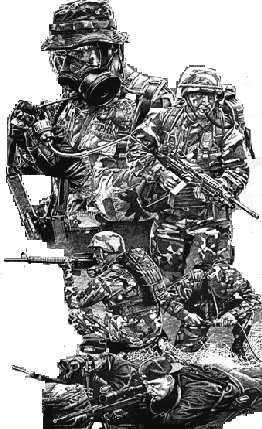
The best way to drink-on-the-move is by using civilian systems like Camel-Bak® which now have military interfaces and are completely "kosher" with National Stock Numbers (NSNs). The following is the simplest way to militarize a civilian black/gray Camel-Bak® without having to empty your wallet:
70 oz. Classic 70 oz ThermoBak from Blackhawk
The standard Camel-Bak® comes in a black and grey backpack, with blue drinking tube though milirary camouflage colors are now available thanks to Soldier customer demand. REMOVE THE FLASHY CAMEL-BAK® LABEL FOR CAMOUFLAGE PURPOSES!!!!! Take a black permanent marker and completely color in the grey side of the Camel-Bak® carrier. Next, buy two drinking tube covers, available from Blackhawk Industries, Part number: 62TC00 or U.S. Cavalry Store for about $1.95. Detach the drinking tube from the bladder and slip on the drinking tube cover. The Camel-Bak® is now completely camouflaged.
CAMEL-BAK® AS ITS OWN PACK
The Soldier wearing LBE/TLBV and rucksack plus myriad other strap gear need not have yet another set of straps tangling up his back and chest. The Camel-Bak® shoulder straps while thin and out of the way have running ends that flop around loose. Cut two 6 inch pieces of the drinking tube cover material and slip it on each shoulder strap to act as a keeper for the excess shoulder strap. The shoulder straps have quick release buckles to speed putting the Camel-Bak® on and taking it off. Detach the buckles and remove the bottom strap from the male buckle to slip over the 6 inch drink tube covers, then re-clip the buckle into the female end and re-thread the strap through the buckle.
CAMEL-BAK® ATTACHED TO ETLBV/TLBV
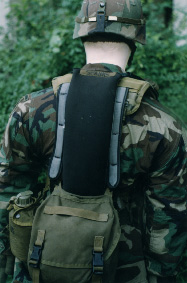
After extensive field wear the Camel-Bak®'s shoulder straps coupled with the TLBV's, MILES harness and rucksack, rifle sling is too cluttered. Unclip each shoulder strap and route through the rear of the ETLBV/TLBV's top shoulder pads. Place the bottom of the Camel-Bak® behind the butt pack and route the bottom shoulder straps under the butt pack eyelets and clip to the top shoulder straps. Tighten all the way. Your Camel-Bak® is now connected to the rear of your ETLBV/TLBV, eliminating a set of shoulder straps around your arms. It can still be disconnected for wear on its own.
CAMEL-BAK® UNDER YOUR SHIRT?
One way to keep the Camel-Bak® camouflaged and out of the way is to wear it over your t-shirt but under your BDU top. The drinking tube has a clip on the right shoulder strap to hold the drinking tube in place. You can still reach into the top of your BDU top and pull out the drinking tube to use it. This carry streamlines the Soldier so only LBE/TLBV and rucksack end up being draped over the outside of the Soldier's back. If this is uncomfortable, the Camel-Bak® can be placed in the hollow recess of the rucksack frame, especially if the synthetic Ram-flex(c) frame is used. Another option is to buy the camouflaged Camel-Bak® carrier designed to clip to the outside of your rucksack if you have the funds.
WHERE DO YOU GET YOUR WATER, PART 1
HOW DO YOU GET WATER INTO THE SMALL OPENING OF THE CAMELBAK®?
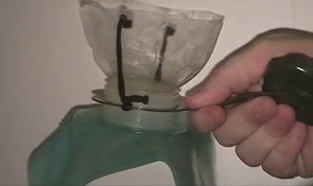
Filling the CamelBak® in the field has always been a pain especially with 50-pound, 5-gallon water jugs. Even the M149 water buffalo trailer is difficult to fill a CamelBak® because the water pours out from the spout at such a high rate. The result of this is wasted water going into the sand/ground. The reason is that the CamelBak® bladder fill spout is off to the side at 90 degrees and hard to pour water into it like from a military 5 gallon water jug, you have to get your dirty fingers on and around the backside of the bladder and pull it away from the spout which you grip at the cap cover connector or hold it directly. You waste water and its unsanitary.
To fix this 1st TSG (A) proposes a "Hydro-Funnel" of very soft plastic in the shape of a cone with a spout that fits snugly INTO the fill spout. Under the Hydro-Funnel would be a plastic tube to grip it with your thumb and forefinger and turn it 90 degrees so its upright under the funnel. As soon as water starts reaching the bottom of the bladder providing weight the two fingers will have tension pulling the rest of the bladder away from them to open the bladder up for a fast fill.
The Hydro-Funnel would be removed from the spout but it would not fall into the dirt because its connected like the fill cap by a length of plastic around the filler spout. The fill cap would be rotated around and closes the bladder. The Hydro-Funnel by being VERY SOFT plastic (like a flexible 1 or 2 quart canteen) would rest flat in the CamelBak® carrier during normal drink-on-the-move operations. Since you may think this is all fantasy we built a working prototype of the Hydro-Funnel and made a short video of it in action below:
www.youtube.com/watch?v=HnG4cfBl4TM
We have also taken some still clips below:
Hydro-Funnel Pic #1
Hydro-Funnel Pic #2
Hydro-Funnel Pic #3
Hydro-Funnel Pic #4
Hydro-Funnel Pic #5
Hydro-Funnel Pic #6
Hydro-Funnel Pic #7
Hydro-Funnel Pic #8
Hydro-Funnel Pic #9
Hydro-Funnel Pic #10
Hydro-Funnel Pic #11
Hydro-Funnel Pic #12
Hydro-Funnel Pic #13
Hydro-Funnel Pic #14
Hydro-Funnel Pic #15
THE NEXT HURDLE: COLLECTING DIRTY WATER, PURIFYING IT AND DRINKING QUICKLY AND SAFELY WITH CAMEL-BAK®S?
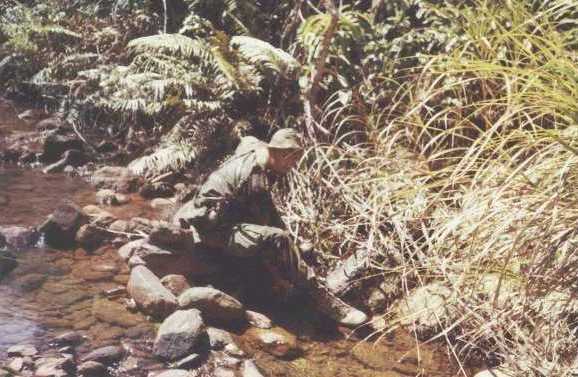
U.S. Army LRRP collecting water from a stream in Vietnam using 1 quart canteen and (we hope) water purification tablets
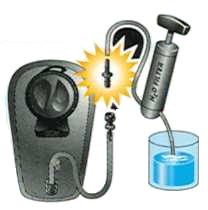
Hydro-link can interface your Camel-Bak tube to a water purifier pump
The British experience in the Falklands war in 1982 show that being a weak little co-dependent relying on the mother bureaucracy to supply you water in WAR will be interfered with by ENEMY ACTIONS. What a non-revelation. The British Royal Marines drank from muddy puddles out of desperation and got very sick which they referred to as the "dog". Here are some excerpts from Captain Wheen's narrative:
"the majority had some sort of "dog" at one stage or another, for we used any water available in the hills - we rarely got water resupply by hel[icopter], the space just was not available).Its true that you should have a canteen cup to boil water to kill any germs before drinking. However, what if you cannot create a fire to boil the water? Excerpt:that I had to evacuate only 1 medical case, and he had a stomach problem.
...and so far as water is concerned, we had to find our own. The nearest stream was 5 miles away - east of the Argentinean regiment at Mt. Harriett. We were on top of a mountain but fortunately the water settled and remained on the surface! In coy hq, 10 of us used a puddle 6 ft. Long, 2 ft. Wide and 6 inches deep for the duration of our stay. Hygiene of course was of crucial interest but luckily no one at this stage suffered from the 'dog'.
. I also was suffering from the "dog". It hit me first on top of mount Harriet after we had taken the main position and were about To strike the rocky outcrop. I must confess that I coordinated both the artillery and mortar fire missions and five minutes later the troop attack with my trousers round my ankles! One way and another no one has ever packed such a punch!
"we were down to one cube of hexamine per troop - this will heat 1 pint of water in calm conditions to boiling point! There are as you'll recall no trees in the Falkland Islands and the peat bog was completely sodden so we had no combustible materials."
Those who think infantry should be in some weak co-dependent state relying on resupply are naive and dangerously deluded. Excerpt:
Non-availability of helo assets prohibited resupply for 5 days. As you can imagine, we were fairly hungry when it eventually came: 2 days' rations don't stretch that far.
Even when the war is over, do not assume that fresh water will be available:
In Stanley, we found dozens of large containers full of food, clothing and equipment; there was no need for us now to go hungry, but water remained a problem and more and more marines got the "dog" as a result.
As Sparks and Schmitt were running equipment designs, prototypes and suggestions up through the USMC "food chain" they learned that DoD wisely DOES NOT WANT ANY DIRTY WATER ENTERING WATER CARRIERS, PERIOD. This guidance has stuck with us all these years and we have tried to alert Camel-Bak® that its concept of having people put DIRTY WATER INTO CAMEL-BAK® BLADDERS and then filter it with a small water filter in the drink tube is unsafe and unsound. As you can see from the past, helpful suggestions being ignored that years later earned them millions, it looks like this bit of progress will have another uphill battle, too.
The whole point of having water purification capability is so Soldiers can gather water as they go and "live off the land" so they can travel fast like Sherman's "flying columns" out-maneuvered the confederates in the U.S. Civil War. The severe water shortages Operation Iraqi Freedom Soldiers endured should never be forgotten as we continue to occupy sizzling 140 temperature Iraq wearing full combat gear.
Contact:
Carolyn Besse
CamelBak® Products
Dept. SOF
1310 Redwood Way
Suite 200, Petaluma, CA 94954
phone 800-767-8725, Ext. 289, for ordering information.
Mike decided to contact Camel-Bak® on the water purification dilemma and asked the following question; "Do you have a water purifier that I can pump into my camel bak so its CLEAN from the get-go?
Here was Camel-Bak®'s reply:
"Greetings!
Thank you for taking the time to write to us. We always love to hear from our CamelBak® enthusiasts!
As a matter of fact, you can purchase a 3rd party [water purifier] pump from a company such as Sweetwater, that can be used in conjunction with our Maximum Gear filter adapter (PN 60093) to BACK FILL clean water into your CamelBak®, just reverse the flow direction on the filter so that the pump flushes the dirty water through the filter and then fills the reservoir with clean water.
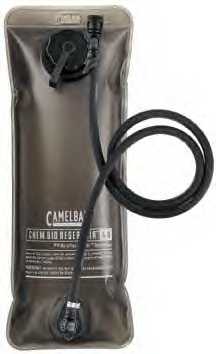 +
+ 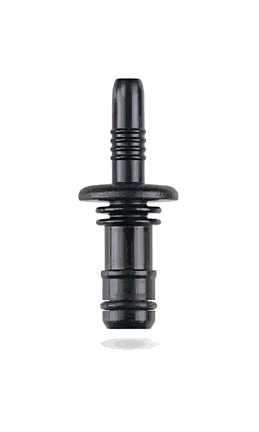 +
+ 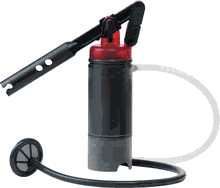 = CLEAN water going into your Camel-Bak as per DoD's sound policy
= CLEAN water going into your Camel-Bak as per DoD's sound policy
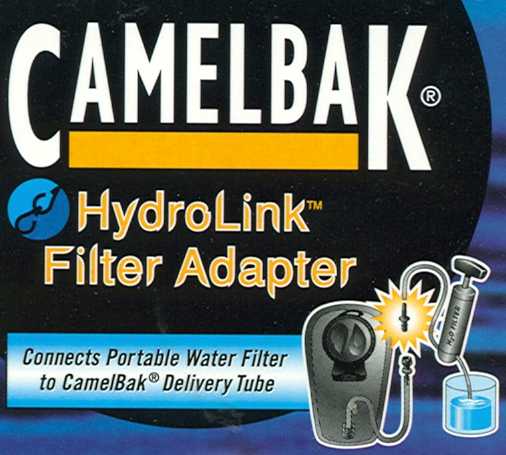

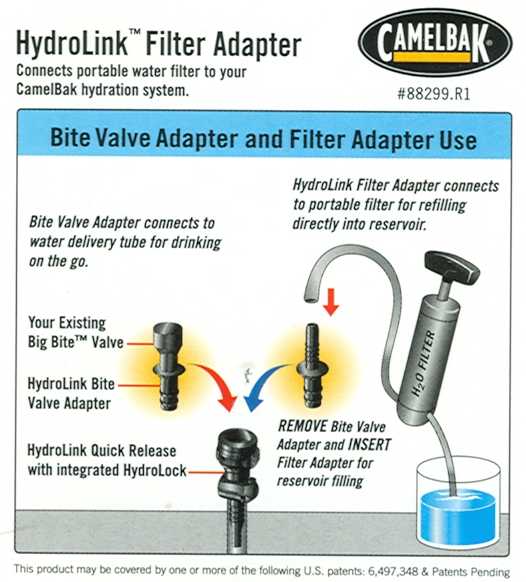
You can find a filter bulb pump or hand pump at just about any outdoor retailer such as REI. Our R & D team is currently developing a CamelBak® pump that will be available sometime in '05.
Our In-line MicroFilter®, which is designed specifically for our MAXIMUM GEAR packs. This In-line filter delivers clean, clear water that's free from 99.9999% of Bacteria and 99.99% of protozoa by using two filtration stages. The first stage uses a carbon composite element to remove sediment, metals, taste etc. from the water and the second stage uses a hollow fiber module to remove protozoa and bacteria. This product filter up to 75 gallons of water and Modular construction allows for easy maintenance and cleaning.
In addition, generally, if in back country, the In-Line MicroFilter alone is adequate. It filters out protozoa such as Giardia and Cryptosporidium which occur in nature. This is the big stuff - larger than .2 micron. Purfication tablets are only necessary when there is a risk of viral such as an urban area (think drinking from Tigris River in Iraq or any river near urban area where runoff and sewage may have had a chance to flow into the water). This is the little stuff - smaller than .2 micron. I have attached a link to our web site where you can find a dealer in your area.
www.camelbak.com/mil/buy.cfm
All you have to do is select Personal Purchase and a list will then appear with the dealers name, address phone number and sometimes web sites. Unfortunately, we do not sell direct to the public at this time and we are not privileged to the inventory the dealers carry. Once the dealers receive our product they can then disperse it any of their locations in the states.
I have included a link to our Maximum Gear® accessories featured on our CamelBak webpage (which includes our In-line MicroFilter) for you to look over.
www.camelbak.com/mil/acces.cfm
I hope that this helps. If you have any other questions, feel free to contact me.
Best Wishes~"
Jennie Anderson
Govt./Military/Industrial Division
CamelBak® Products, LLC
1310 Redwood Way, Ste. C
Petaluma, CA 94954
janderson@camelbak.com
(707) 792-9700 Ext. 227
(707) 665-3844 Fax
Mike Sparks: I would not suggest drawing in bad water AT ANY TIME where its germs could ferment in your Camel-Bak® bladder. Only draw in CLEAN water (which is hard enough to keep pure) and even then add an inline filter as an extra security measure. Its your LIFE and your HEALTH weighing in the balance.
Older Katadyne water purifiers only have a spout to pump out purified water.
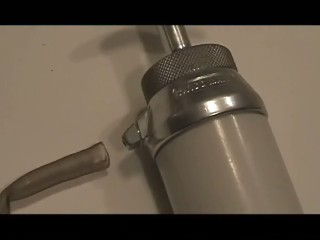
The good news its an aluminum spout that with a hack saw you can carefully cut a notch to create a barb for a short length of CamelBak® tubing to fit over it securely.
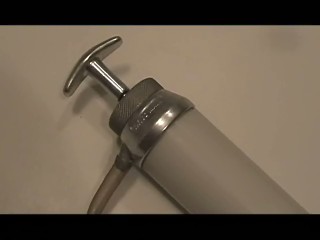
VOILA! Katadyne-to-Hydrolink-to-CamelBak® drink tube-to-bladder interface!
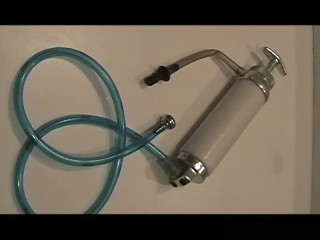
Another way to purify water is by BOILING IT. What if you don't have a stove or heat tabs?
Use a "Tommy Cooker" or Natick Stove. However, these require heat tabs and the Army went out of the heat tab business with the flameless ration heater. Now they are "discovering" they need to heat water for dehydrated LRP/RCW rations somehow using vehicle JP-8 fossil fuel....
However, this might be a way to get a JP-8 fueled stove to cook REAL FOOD in the field to raise morale, build unit cohesion and create SELF-SUFFICIENCY TO FORAGE FOR FOOD and have independent operations.
BUT WHERE are you going to get the JP-8 if you are in a light infantry unit???
Hmmmmm
AGAIN, again, damn it AGAIN yet another reason why M113 Gavin light tracks should be ORGANIC to the light infantry, so they can heat their food----
RDECOM Magazine
www.rdecom.army.mil/rdemagazine/Current/itl_capillary_force.html
Capillary force fuels pocket stove
U.S. Army Natick Soldier Center Public Affairs OfficeOnce you hear the slight puff and see the yellow flame mellow into a glowing blue, you know the capillary force vaporizer has gone into action.
The vaporizer is a breakthrough in burner technology being applied to the Modular Individual Water Heater, a jointly developed product of the Department of Defense Combat Feeding Directorate's Equipment and Energy Technology Team at the U.S. Army Soldier Systems Center here, and Mountain Safety Research (MSR), a division of Cascade Designs, Inc. in Seattle, Wash.
Trioxane fuel bars had been the source for warfighters to heat water for beverages, dehydrated rations and personal hygiene, but there were drawbacks and production has been discontinued, said Leigh Knowlton, project officer.
"Soldiers had supply problems because they're considered fuel and ordered separately from food. It will also evaporate if the seal is broken in storage and can give off noxious fumes when burned," he said.
Knowlton said little has changed in the last 40 years in this area of warfighter sustainment. Current authorized equipment to heat water consists of a plastic canteen, steel cup, cup stand and cover. Absent the fuel bar, the alternative is the military's squad stove, a commercial product that has an external fuel tank with a pump to build pressure and prime the stove.
"It's heavy because of the bottle, has a lot of moving parts, it's expensive, and it's not about efficiency-it blasts out heat," Knowlton said. "If you can use less fuel, that's less fuel to carry."
Meal, Ready-to-Eat (MRE) rations have a flameless heater for the entrée and upcoming pouches to make hot beverages, but there's still a void for the dried foods found in the Long Range Patrol/Cold Weather Ration, which require 28-40 ounces of hot water for all the components. He said the situation will worsen if the canteen cup is phased out because of the increasing popularity of bladder hydration systems.
With no existing commercial stove or water heater that's lightweight, compact, compatible with on-the-move hydration systems and meets the military's requirement to burn JP-8 fuel, the capillary force vaporizer invented by Vapore, Inc. in Richmond, Calif., became the solution.
Three-part Wick
About the size and shape of a pair of antacid tablets, the three-layer vaporizer held together by an impermeable exterior glaze has no moving parts and fits inside a cone-shaped stove where it converts liquid fuel into a pressurized gas. Knowlton said the vaporizer is durable as well, working for hundreds of hours before wearing out.
A coarse ceramic layer at the bottom is the feed wick that touches the fuel. In the middle is the boiler wick, a fine ceramic layer that generates high capillary pressure and vaporizes the fuel. On top is the orifice disk that conducts heat from the flame to the boiler wick and has one or more pinhole-sized openings to expel fuel vapor.
"Because there's no pressurized tank, it's potentially safer. If something goes wrong, it just goes out," Knowlton said. "MSR is excited because this is their route to a revolutionary product."
As configured in the current prototype, the stove is unpacked from its own commercial steel mug, but Knowlton said a sack may become available so it can be carried independently.
Starting it is as simple as holding the stove upside down for 30 seconds for priming, turning it upright and lighting the priming wick with an MRE match. Within 60 seconds, the capillary force vaporizer takes over, emitting a whooshing blue flame. A sliding steel lever with off, simmer and full settings regulate output.
The mug filled with water is placed on the stovetop pot support and windscreen. Knowlton said the commercial cup, which is designed to improve heat transfer efficiency, could be offered for the military version, or the system may be modified to accommodate canteen cups.
Another heat transfer system is the hot water coil, which was developed to easily heat water from hydration packs.
Once described as resembling an elephant stethoscope, a flexible plastic tube connects to the water bladder and feeds water to a metal heat exchanger that attaches onto the pot support and windscreen. A valve inside the heat exchanger releases hot water through another tube that can be directed into a dehydrated meal or beverage pouch.
With either method, a pint of water is heated in six to 10 minutes. The stove system has twice the energy efficiency of a squad stove, burns JP-8 and holds enough fuel in its tank to last for three days, Knowlton said.
Cold weather Army and marine corps units are likely early adopters, according to Knowlton, although all the services have shown interest. MSR plans on selling a white-gas version of the stove as part of their product line of outdoor recreational gear.
Combat Feeding and MSR built the stove under a cost-sharing contract, and the technology base could lead to more products.
"The vaporizer technology has interesting applications beyond stoves," Knowlton said. "Vapore is leaning toward medical devices. But for military applications, it has potential for anything that needs a small amount of vaporized fuel, and that's challenging to do with JP-8."
Beverage chillers, personnel warmers, lanterns, generators for individual warfighter equipment and infrared markers are examples of small heat-driven devices for the military.
Knowlton said more research is going into the hot water coil and mug to increase their efficiency and reduce weight. The commercial stove will be ready next year, with the military version possibly being fielded in limited quantities before commercial sales.
WHERE DO YOU GET YOUR WATER, PART 2: HOW ABOUT FROM THE AIR OR YOUR VEHICLE EXHAUST?
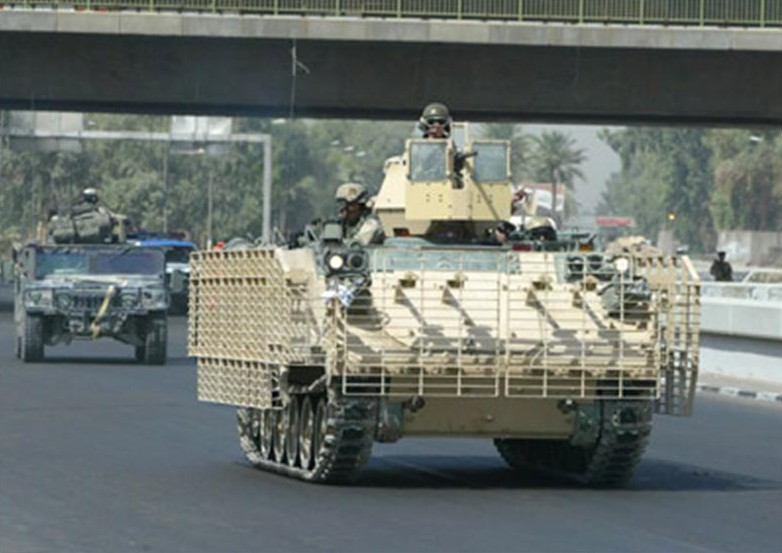
This M113A3+ "Super Gavin" would be the ideal infantry squad "mother vehicle" to give armored cross-country mobility, carry weeks of food/ammo, cook food, charge batteries AND CREATE POTABLE WATER!
Drinking water from the air and engine exhausts = yet another self-sufficiency for 3D operational maneuver.
Exhaust Water Formula:
M113 Gavin has 95 (100) gallons of fuel = 50 gallons of water
This water could be stored in the V-hull bottom and side tanks to improve armor protection from blasts, too. What we're suggesting is YOU START THE MISSION WITH WATER TANKS FULL, as the men drink it and urinate it out, the ENGINE REPLENISHES THE WATER AS YOU GO.
50 gallons = roughly water for 5 men for 10 days (driver, TC, 4 scouts) CAV-type mission
or:
water for 10 men for 5 days (driver, TC + 9 infantry) INF-type mission
This does not include recovering water from ambient air moisture which could be a ratio limited only by engine operation fossil fuel use/supply.
This eliminates the need for ANY water resupply. As said before, we would also have water purifiers to collect water as its found, also.
Now we are down to:
a. Fossil fuel
b. Ammo
c. Food
Fossil fuel and ammo can be captured by "VULTURE" squads to use enemy supplies and weapons against them. Food can be foraged with SERE and field cooking skills--if non-linear resupply cannot get through.
www.rdecom.army.mil/rdemagazine/200506/itl_operationH2O.html
Operation H2O
By Ashley John TARDECIt is essential that a Soldier receives one to three gallons of water per day to prevent dehydration. If you add personal hygiene, combat meal preparation and emergency medical treatment to the mix, a single Soldier may need up to 6.6 gallons of water per day. Without advancements in water sustainment technology, water distribution is anticipated to account for 30-40 percent of the Future Force daily sustainment requirement.
The U.S. Army Tank Automotive Research, Development and Engineering Center joined with the Defense Advanced Research Projects Agency, to develop two distinctive technologies that can generate and purify water anywhere on the battlefield. Both of these technologies will reduce the Army's logistical footprint which will ultimately reduce the frequency and quantity of water supplied to the Soldier.
The air that surrounds us on a daily basis contains a considerable amount of water, but Army conventional methods of collecting water from air are energy intensive and too large to be of productive use on the battlefield. TARDEC, in collaboration with DARPA, MesoSystems Technology Incorporated, Honeywell International Incorporated (Airframe Systems) and Hamilton Sundstrand Corporation are focusing resources into a water-generation system that can extract water from air. The Water Recovery Unit from Air system will have the capability to provide a source of stand-alone-water or the technologies sufficient enough to be integrated onto military vehicle systems.
TARDEC's efforts on equipping the force with additional water by means of air are set on the thermal-swing adsorption method. With this method, air is passed over the surface of an adsorbent, which collects water from the air in an adsorbed state inside small-diameter pores. Recovery of the water from the adsorbent requires the addition of heat, characteristically in excess of water's latent heat of vaporization. After sufficient heat is added, the water will desorb and form a high-humidity and high-temperature mixture of water vapor and air. Passing this mixture through a suitable condenser allows the water to be collected as a liquid.
TARDEC's WRUA system will be proficient enough to fabricate potable water over an operating environment of 20 to 120 degrees Fahrenheit ambient temperature, 20-100 percent relative humidity, and a minimum dew point temperature of 20 degrees Fahrenheit, while supplying purified water for up to a dozen Soldiers at any given time. Both the stand alone system and the vehicle integrated system will be ready for military vehicle integration by 2007.
The Water Recovery Unit from Exhaust (WRUE) generator has the capability to generate drinking water by capturing water from fuel expended by engines on the battlefield. This system can be embedded onto military platforms, and will also feature low energy and lightweight devices that hold the ability to purify water on combat platforms.
TARDEC, in conjunction with Lexington Carbon Company and Hamilton Sundstrand Corporation have developed a WRUE for three military platforms; the HMMWV, a 10kW generator, and the Unit of Action demonstrator, the Lancer.
TARDEC developed, fabricated and integrated a WRUE system on the Lancer vehicle and in March they integrated and tested the system on the 10kW generator. By July TARDEC plans to have a WRUE system ready to be integrated onto the HMMWV. This system has already demonstrated its ability to recover water from a stationary vehicle and a vehicle traveling up to 20 miles per hour.
According to TARDEC WRUE manager Dr. Jay Dusenbury, "water from the exhaust concept is based on water formed during the combustion process as the hydrogen present in fuel is oxidized by the oxygen present in air resulting in water in the exhaust."
To recover potable water from engine emissions, water is condensed from exhaust gas and then purified using a three-stage filtration process. The portion of the exhaust that is unused leaves the vehicle through an exhaust port, while the condensed exhaust is collected in the water receiver. A water pump then sends the exhaust condensate from the water receiver to the water purification subsystem. The water now waits to be purified through the use of three separate filters; a particle, activated carbon and ion exchange resin. To help monitor the life of the filters, sensors are mounted inside the crew compartment of the vehicle to let Soldiers when the system is in use, and it also allows Soldiers to turn it off when it is not needed.
For each gallon of fuel consumed by the vehicle, .5-.6 gallons of drinkable water is recovered for the Soldier. Once enough potable water is collected in the five gallon on-board storage tank, the Soldier has the ability to draw water from a tap located in the crew compartment or the rear passenger side of the vehicle. The WRUE system will enable the Warfighter to operate without an external resupply of water for an approximate duration of three to seven days. Furthermore, this system will provide the Solider with improved combat power and increased agility and mobility, by being able to drink a sufficient supply of water.
Keeping the Warfighter hydrated is imperative to the successful completion of missions and for day to day operations on the battlefield. These systems both possess the potential to revolutionize battlefield water sustainment by generating supplemental drinking water wherever the Soldier located, reducing the quantity and frequency of water that has to be resupplied to the Soldier. TARDEC became aware of an apparent need for the Soldier, and with the aide from various partners, developed two solutions to augment the amount of potable water a Soldier can receive and store in any given day.
(Author's Bio: Ashley John is a Booz Allen Hamilton contractor working in support of the TARDEC Technology Promotions Team. She holds a Bachelor of Arts degree in Business Marketing from Michigan State University. )
KEEPING YOURSELF COOL BY KEEPING YOUR WATER COOL
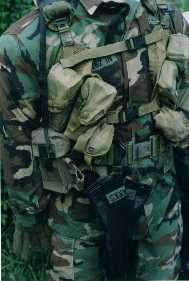
Vital to proper hydration and cooling is the water itself being cool. Studies prove that cool/cold water better lower the body's core temperature than drinking warm/hot water. By wetting the fleece lining inside your one quart canteen covers with water, some evaporative cooling will take place. Camel-Bak® has a mylar cover ("Cool Skinz" about $12) that when slipped over the bladder can keep water inside cool even in the desert. The superb desert water bag used in the deserts of California at 29 Palms when Sparks went there for USMC combined arms exercises (CAXes) achieves this by whole-membrane evaporation. These bags need a Camel-Bak® style carrier and drinking tube to exploit its potential. Readers can help by contacting the maker of these bags, Canvass Specialties and Blackhawk Industries which makes accessories for Camel-Baks®. Their information is listed below.
Here is some proof that Soldiers in Iraq are using our Field Expedient advice and wetting down their CamelBaks® to get evaporative cooling effects:
www.xylitolinfo.com/web/xy/default/presentation/home/archive/newsarchive.html
September 08, 2004 - Keeping Cool is Hot
Newsweek
Title: Keeping Cool Is Hot
Date: July 12, 2004
It's so hot in Iraq right now that Soldiers are pleased if the air conditioner can get the temperature below 90 degrees. But what really cheers them is care packages stuffed with heat relievers. Powdered water flavoring is more popular than the latest Xbox game or NASCAR magazine. "Soldiers do a little happy dance when they open up a package and find powdered Kool-Aid," says Army Lt. Col. Dan Epright, posted in Baghdad. He keeps cool with one of the hottest new gadgets, a bandanna lined with a thin, gel-filled tube. Store it in a fridge--if there's electricity--for a few hours, and it becomes a cool ring of air for an entire shift. The handheld, battery-powered fans popular last summer bowed to the new-and-improved battery-powered fan and water-mister combo. And, of course, wearable CamelBak hydration systems are a must. Ingenuity helped Larry Edwards and the Soldiers of the Mississippi National Guard's 223rd Engineer Combat Battalion beat the heat. They soak a sock, slide a bottle of water inside and let physics take over. Evaporation off the sock draws energy in the form of heat out of the bottle. When the sock dries, the water is cool. Soldiers on the go request tuna fish packaged in the new foil pouch; it's light and doesn't require a can opener. The heat is also bad for troops too busy to brush their teeth. To zap their petri-dish mouths, they like Carefree Koolerz gum containing xylitol, a bacteria killer. Certain other relief agents are verboten in Islamic society: don't bother sending your favorite GI alcohol, pork or porn. It's hot enough without them.
Copyright (c) 2004 Newsweek, Inc.
WHERE DO YOU GET YOUR WATER, PART 3
Let's say the Army supplies you water...
If you have it in 5 gallon plastic water cans filling up your G.I. CamelBak® with its long neck is clumsy and results in lots of spilled water. CamelBak® has offered an ergonomic handle plastic at the spout of civilian models that will hold the spout out away from the bladder to open it up for filling. But our 1st TSG (A) Director Mike Sparks has recently contacted the company suggesting a soft plastic "Hydro-Funnel" be connected to the handle so no water is wasted by missing the spout while holding a 50 pound water can and trying to pour water in. When not needed, the soft plastic funnel flattens and is not noticeable. We will keep you posted if the funnel gets made into a reality.
Another option some Soldiers from the cursed Stryker truck brigades suggested to us at the AUSA show was a PUMP that would draw water from the 5 gallon can DIRECTLY INTO THE CAMEL BAK® DRINKING TUBE. There are some excellent siphon/pumps available commercially with a rotary handle pumping action that could easily send water through a tube into the CamelBak®'s fill neck, the 1st TSG (A) hasn't determined the best one for cost/performance yet. We are also experimenting on getting the siphon to shoot into the drink tube via a Hydralink® valve.
About 5-gallon water cans...these $35 items are cumbersome when you only have 1-way supply in effect like when you receive airdrops. You need 2-way resupply by airlanding aircraft or ground vehicles and a safe situation to exchange full water jugs for empty ones. To prevent having to carry around empty 5 gallon water jugs, use collapsible waterbags in MRE cases for 1-way resupply situations. These disposable water bags collapse like flexible 1 and 2 quart G.I. canteens and take up no room in your rucksack or ground vehicle if you decide to keep them and reuse them.
THE PUSH-PULL DRINK SPOUT SHOULD BE ON EVERY HAND CARRIED WATER DRINKING CANTEEN/BAG/BOTTLE
The latest U.S. Army water purification systems used by dedicated Reverse Osmosis Water Purification (ROWPU) units use 1 liter bags with push-pull spouts so the Soldier can carry them in his BDU trouser pocket. Remove them and drink-while-on-the-move like a sports drink bottle. ALL future canteens should have the ability to be drunk hands-free by a drinking tube or one-handed using a spout. We contacted Cascade Designs, maker of the Platypus® flexible water bottle in 1998 and tried to get them to help our Soldiers. The Platypus has a push/pull drink spout so you can hold it in one hand and drink-on-the-move. Not hands-free like a CamelBak but better than having to stop and guzzle down an open topped G.I. canteen. Problem is Platypus® bottles will not fit into G.I. canteen covers. So we wrote to Cascade Designs and suggested they make a G.I. 1-quart version that would fit into the canteen cover. They could get the NBC caps from other manufacturers, all they'd have to do is mold a soft plastic canteen with a push/pull drink spout and a fill neck/spout with threads for the NBC cap.
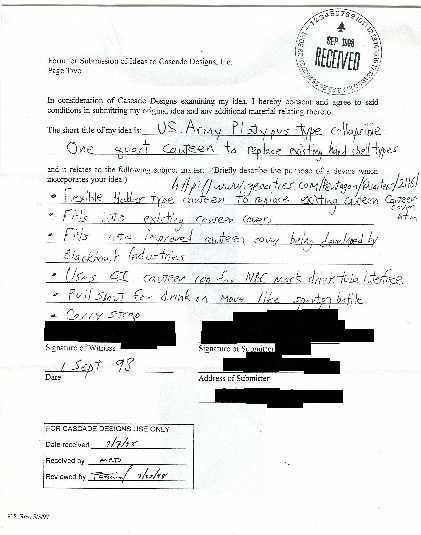
Here is the drawing we passed on to Cascade Designs through our old geocities AES web page of the G.I. Platypus®:
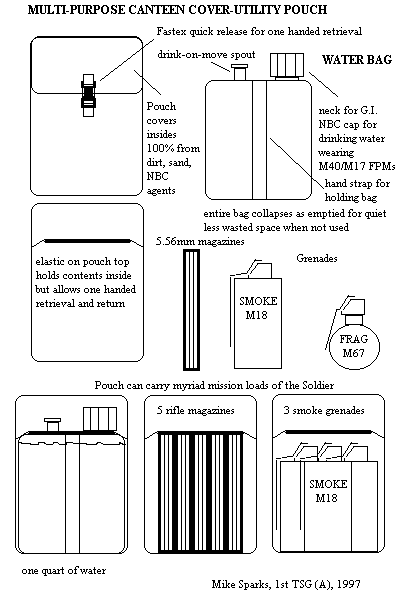
Not too hard, right? This is the "modern" era, right?
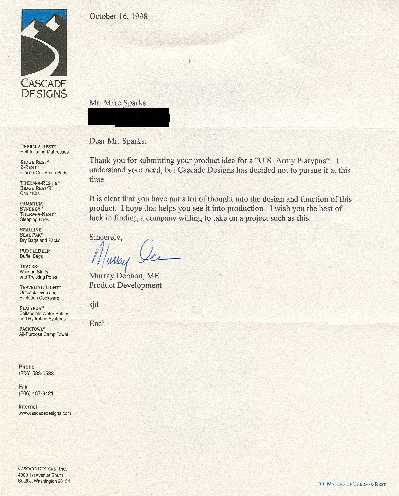
WRONG! This was years before 9/11 and there was neither a sense of urgency to defend America or make a buck off the taxpayers in effect.
1st TSG (A) in U.S. Army LOGISTICIAN magazine January/February 1998 issue:
www.almc.army.mil/alog/issues/JanFeb98/JF98Lognote.htm
"Water Availability and Use The world is urbanizing. . .and natural disasters are on the rise. Major Tubbell's excellent article on PLS flatracks shows that it's possible to set up a firefighting module using 3,000 gallons of water, pumps, and related equipment on a flatrack for Army units to use in fighting fires in the cities during war or natural disasters. One PLS truck could move a flatrack or firefighting module to several locations for fighting fires. Army combat engineers could fight the fires as empty modules are brought back to a water point for refilling. Please contact the good Major for me on this urgently needed PLS development. Water is scarce in underdeveloped areas and areas where disaster has destroyed water points; such a modular firefighting capability could save thousands of lives. I also liked Captain Choi's article on ROWPU [reverse osmosis water purification unit] water being stored in bags. It was our non-profit 1st Tactical Studies Group (Airborne) that pioneered the effort to get the U.S. Army to adopt drink-on-the-move capabilities. There is now a long drinking tube that connects a canteen to the drinking tube of the M40 field protective mask. I'd like to contact the ROWPU bag developers, get some bags, and develop and perfect a drinking tube interface so Soldiers can put a ROWPU bag in their rucksack and drink from a tube while on-the-move."
Mike Sparks, Fort Bragg, North Carolina
ALOG STAFF:
"Thank you for expressing your interest in Major Tubell's and Captain Choi's articles. Shortly after we received your letter, ALOG staff members provided you with points of contact on both of these topics. By now, we hope you have been in touch with the Army Center for Health Promotion and Preventive Medicine, Aberdeen Proving Ground, Maryland, concerning the water bags and the Program Executive Office for Tactical Wheeled Vehicles, Warren, Michigan, to discuss your ideas on the PLS." -Editor
The Soldier himself should be able to collect and purify his own water with a hand-pump operated purifier instead of hoping his iodine tablets are not faulty or that the Army supply system works. Combat operations in the Falklands and Iraq show that institutional water resupply can fail. Fortunately, there are even hand-pump ROWPUs that purify sea water in use by U.S. Navy SEALs. Current logistics SOP is 7 gallons of water per day per man in the desert. This means we are carrying water cans and water buffalo trailers instead of war-winning light Armored Fighting Vehicles and ammunition. We can eliminate this logistical handicap by equipping our infantry to purify its own water if local sources are available.
Combine this with a Meal-Ready-to-Eat (MRE) with a LARGE sports drink beverage powder, and you have optimized Soldier hydration. Initial laboratory studies indicated that warfighters will extend their physical endurance by approximately 17 percent by consuming an energy rich-beverage.
http://www.natick.army.mil/warrior/99/mayjun/rations.htm
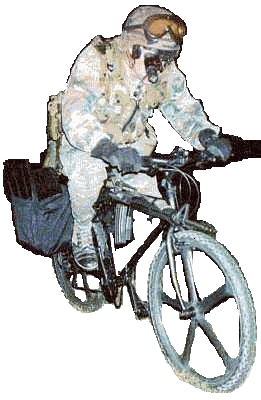
Bikers and backpackers who are demanding greater human performance are "driving the train" here. The military needs to be laying down some of its own tracks.
However, where's the MRE drink mix that will fill at least a 1-quart canteen?
In 1997, with Camel-Bak® finally catching on, the 1st TSG (A) was in contact with some people at Natick Labs that wanted to improve Soldier gear using common sense and not wait for a general officer to "see the light". Carol Doring asked Mike to FAX her what he meant by an improved MRE meal that offered side slots to open meals, a "SPORK" micro-hygiene device and a Nutrasweet® flavored drink mix that would be actually smaller than the current sugar-flavored canrteen cup drink mix, but would FLAVOR AN ENTIRE 1 QUART CANTEEN.
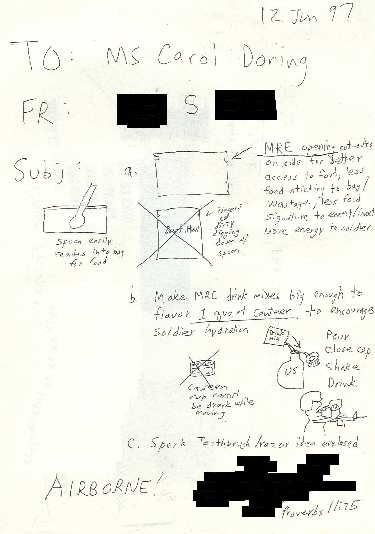
Notice earlier in the NEWSWEEK report from Iraq that Soldiers are desperate for family/loved ones to send them flavored drink mixes to them. WHERE IS NATICK? They only supply a pathetic amount of sugar-flavored powder in MREs. No infantryman has time on the move or even stopped for chow to waste water rinsing out a dirty canteen cup just to make Kool-Aid® using the absurd MRE drink mix. If you pour the limited size packette of drink powder into your 1 quart canteen, you get water with a funny color and a faint after-taste. The question still stands: WHY NOT ADD SOME NUTRASWEET TO THE DRINK MIX SO IT WILL FLAVOR AN ENTIRE 1-QUART CANTEEN? 3 drink mixes from a daily diet of 3 MRES (we pity anyone who has to eat this many MREs) would flavor an entire Camel-Bak®. By mixing some Nutrasweet or similar potent flavoring like Splenda® into the current sugar-flavored drink mix to extend it to a 1 quart application insures Soldiers get the calories for energy as well as the water for hydration. As you can see later on in this narrative that units are having to buy their own water flavorings for Iraq no thanks to Natick.
Evaporative Cooling "Desert" Water Bags
Blackhawk Industries
Virginia Beach, Va
(804) 436-3101 FAX: -3088
KEEPING YOUR CAMELBAK® CLEAN: I'M GONNA WASH THAT BACTERIA RIGHT OUT OF MY TUBE!
One of the by-products of using sugar-flavored drink mixes sipped through a covered tube is that if you leave it there a nasty black bacteria will grow! Sparks just field-stripped his CamelBak® for the Katadyne-to-Hydrolink interface photos and noticed his clear drink tube was not a charcoal gray BUT BLACK! Q-tips in the ends of the tube revealed it was bacteria! He promptly got a straightened coat hanger and scrubbed the rest of the black out of the drink tube which is now soaking in bleach water for sterilization. Conclusion? A.) CamelBak® should include a drink tube cleaning brush with every bladder system they sell no matter what to insure Soldier's have the ability to clean their drink tubes to stay healthy. The Bianchi M12 holster for the M9 Beretta pistol has a small plastic cleanining rod ORGANIC, so why not CamelBak®? Again, a small slot/pouchette should be on the carrier to store the cleaning brush. B.) until they offer one, go buy a cleaning brush C.) until you can get a cleaning brush use a straightened coat hanger; the end where you open it up is slightly wider and acts as a scraper inside the plastic tube D.) we should use non-sugar drink mixes in CamelBak® to reduce the risk of fermentation.
2004-5: If the Water Tastes Bad, Will You Drink it?
CamelBak®s are still problematic to jump under a parachute harness and to carry bulk water. So the 1 quart canteen is still needed, it just needs to be FLEXIBLE so if you land on them you do not get hurt. All of this water will not help if you are loathe to drink it and you get thirsty and force yourself to drink it--too late you are already dehydrated.
Consider, CPT Jason A. Miseli's article in the September-October 2003 issue of U.S. Army ARMOR magazine; "The View From My Windshield: Just-in-Time Logistics Just Isn't Working" page 11,
www.knox.army.mil/center/ocoa/ArmorMag/so03/5miseli03web.pdf
EXCERPTS which state:
"When a mechanized infantry BCT cannot get more than one or two bottles of water per Soldier, per day, and must subsequently rely on locally purchased water and poor-tasting bulk water to meet essential sustenance, does our just-in-time logistics systemrespond? The answer is simply no. Instead, we default to the failure culture and the associated safety nets that support that culture. As of 15 May 2003, the CSR for the 3d ID was two bottles per Soldier per day because our division was fifth in the theater's priority of resupply. By 21 May 2003, the response to our requests for water was even less acceptable: the 3D BCT was supposed to leave in mid-May. Well, the grim reality is that we are here, and we are now drinking Iraqi water. Sadly enough, it tests as clean or better than our own bulk water, and fortunately, 24 hours later, none of us have had any adverse reactions."
SOLUTION:
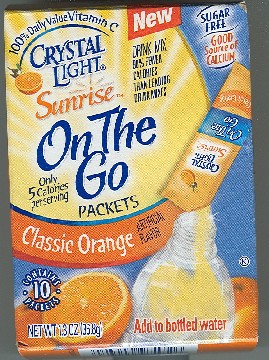
Packette (what should be in every MRE)

As most of you know, the MRE comes with a pathetic packet of defacto Kool Aid® (sugar flavored drink mix) suitable just for 1 canteen cup of water.
Dude!
No one has got time to wash out the canteen cup and make Kool Air...either its in the 1 quart (32 ounces) canteen or camel-bak or its not there.
Visiting Wal-Mart last night I found something believe it or not--- that IS NOT MADE IN CHINA----Crystal Light ON-THE-GO® drink packets that will flavor 1/2 a canteen....16.9 ounces....
So here is the idea....
Units buy en masse Crystal Light® packets to flavor either bottled water or in concert with MRE packets, 1 quart canteens.
Get this going as common troop SOP so it shames Natick Labs to offering Crystal Light® packets in each MRE with the sugar flavored Kool Aid® packet.
Now examine how Natick is refusing to meet Soldier's need for adequate drink mix. Rather than provide more drink mix to flavor a 1 quart canteen, Natick wants a plastic bag in MRE because the amount of drink mix they provide is only enough for a canteen cup that Soldiers don't have the time to clean to use!!! Someone must be getting bribe money under the table to buy their plastic bags, perhaps the drink mix companies refused to "cut a deal"?
Well no shit Sherlock, Soldiers don't pour the MRE drink mix into dirty canteen cups. We've been telling Natick this for what, 8 years now? They had to take a "survey" before they admitted to the obvious.
Now, rather than admit their tiny MRE drink mix is too small THEY WANT TO ADD WEIGHT/COMPLEXITY/COST TO THE MRE WITH A RECLOSABLE DRINK BAG.
This is disgusting.
Instead of adding PLASTIC, why not use that money and weight to add MORE DRINK MIX SO IT CAN BE POURED INTO THE 1 QUART CANTEEN TO FLAVOR IT? SO SOLDIERS DON'T HAVE LOVED ONES SEND THEM DRINK MIXES IN THE MAIL...
And where in the fuck is this "army doctrine" prohibiting anyone from pouring drink mixes IN MY FUCKING CANTEEN THAT THE INDIVIDUAL SOLDIER FUCKING PAID FOR AND OWNS? What's the cost here, $2 each? This must be something Natick pulled out of its ass to cover their ass. The REASON WHY SOLDIERS DON'T POUR THE DRINK MIX INTO THE 1 QUART CANTEEN IS BECAUSE IT TASTE LIKE SHIT BECAUSE THERE IS NOT ENOUFGH DRINK MIX TO FLAVOR ALL THE WATER INSIDE.
May 2004
www.rdecom.army.mil/rdemagazine/200405/itf_pouches.html
RDECOM Magazine | in the field | TITLEPouches change drinking practices for Soldiers
By Soldier Systems CenterNATICK, Mass. -- Pouches that can be resealed are changing the way troops drink.
Drink pouches developed by the Department of Defense Combat Feeding Directorate at the U.S. Army Soldier Systems Center in Natick, Mass., in partnership with packaging companies Pactech in Rochester, N.Y., and Kapack in Minneapolis, Minn., allow warfighters to pour water into a package holding a powder mix, shake and consume the beverage from the opening. If they want to save some for a little later, the plastic zipper seal holds it in.
Often they didn't bother preparing a beverage in a separate container. Field data showed that about half of the Soldiers are not consuming the Meal, Ready-to-Eat (MRE) beverage base mix because of the inconvenience of using and cleaning the canteen cup, said Lauren Milch, a physical scientist at Combat Feeding who managed package development. Pouring the mix into a canteen full of water is prohibited according to Army doctrine, so the packages are frequently thrown away unopened.
The 12-ounce beverage pouch is the first project of the Individual Combat Ration Team's Improved Packaging for Combat Rations program aimed at reducing packaging and increasing consumption, said Vicki Loveridge, a senior food technologist and project officer for improved packaging.
She said including a resealable plastic bag was a partial solution, but the drink pouch takes care of everything by replacing the current dry mix package with a disposable drinking vessel.
Originally intended to replace the MRE beverage base mix, the beverage pouches could be used for any of the military ration beverages or liquid foods, such as dairy shakes. For hot cappuccino or cocoa, the pouch was designed to fit into the flameless ration heater.
A rectangular drink pouch with a plastic zipper was evaluated in 1991, but it was shelved because the cost was considered "extravagant" at 25 cents apiece, Loveridge said.
In the last three years researchers developed prototype pouches with a non-reclosable tear-off spout, reclosable sports-type pull cap and a twist-off cap that were studied along with the final package design.
"We wanted something reusable, and they didn't want or need (a pouch) to stand up, just a way to set it down," Loveridge said. "The extra expense of a stand-up pouch was unnecessary, and it's a harder pouch to keep from cracking."
In the first evaluation with a twist-off cap pouch in 2001, 91 percent of the troops consumed their beverages, but the twist-off cap was too bulky and expensive. The latest prototype has a tear-off portion just above a resealable interlocking plastic zipper on top and slight hourglass shape for easy holding.
"What's very different from what you see at the grocery store is the zipper with a multi-laminate foil and three-year shelf life requirement," Loveridge said. "It's difficult to incorporate a zipper without compromising the foil."
With four studies already showing substantial percentage increases in the number of troops using the beverage pouch, another field test is scheduled to determine how warfighter performance improves with increased hydration.
An order of 7,000 beverage pouches has been placed for two Combat Feeding developmental products, the Remote Unit Self Heated Meal and First Strike Ration, according to Loveridge. An electrolyte-based drink powder beverage pouch was approved for four varieties of the 2004 MRE menu and could be fielded as soon as September.
"The drink pouch is something they really need, and it's designed to add minimal cost," Milch said. "We hope it takes off in popularity like the mini bottles of Tabasco sauce and flameless ration heater."
Anything but admitting Natick is wrong and changing MRE drink mixes to have adequate amounts to flavor the 1 quart canteen...here's another BS project from Natick to work around instead of FIXING MREs...
We suggest grabbing 2 x "Carbopacks" to get 32 ounces worth of drink mix, pour it in your damn 1 quart canteen and solve the problem.
www.rdecom.army.mil/rdemagazine/200402/itf_nsc_carbopack.html
RDECOM Magazine | in the field |Energy-restoring CarboPack heading to Iraq
NATICK, Mass. -- Extra energy for strenuous military operations is now conveniently supplied with the Carbohydrate Supplement Pack, or CarboPack, developed at the U.S. Army Soldier Systems Center.
The CarboPack contains one carbohydrate-rich bar and two packages of flavored carbohydrate-electrolyte sports beverage powder to mix two eight-ounce servings, and is intended to complement current and future military rations.
"Studies show that Soldiers in intense, prolonged physical activity for more than three hours need the calories beyond what's provided in rations," said Julie Edwards, a food technologist at the Department of Defense Combat Feeding Directorate. "Most of what they need is provided in their rations. This is designed to make up the difference in calorie needs during prolonged exercise."
The CarboPack adds another 400 calories to the battlefield diet. By comparison, a day's worth of Meals, Ready-to-Eat, MRE, is more than 3,600 calories. Research that went into the CarboPack will give troops a product that's proven to perform while saving troops money.
"We identified a need because Soldiers were buying their own bars and drinks," Edwards said, which opened up potential pitfalls. "By providing Soldiers with the right products we can decrease the chances that the Soldier will bring the wrong type of item to the field with them that may potentially hurt their performance."
[1st TSG (A) EDITOR: wait a minute! Why doesn't Natick have this attitude with hygiene devices? Why are they not concerned that they might buy the wrong hygiene products and harm their HEALTH? The hypocrisy here is telling. When its something Natick doesn't want to do, "fuck-you, Soldier buy it yourself." If Soldiers are BUYING SOMETHING THAT EMBARASSES THE BRASS ALL OF THE SUDDEN NATICK DOESN'T WANT THE WEAK CO-DEPENDENTS GOING OFF AND DOING SOMETHING THAT MIGHT HURT THEIR "PERFORMANCE"]
Combat Feeding's Individual Combat Ration Team, the U.S. Army Research Institute of Environmental Medicine at Natick, Office of the Surgeon General and Army Center of Excellence Subsistence worked together on product guidelines.[1st TSG (A): was this their suggestion? Or did Natick fucking conveniently cut out the suggestions of Soldiers who made the common sense observation to offer enough sports drink mix to FLAVOR A 1 QUART CANTEEN SO YOU DON'T NEED ANOTHER BAG OF PLASTIC TO CARRY AROUND? Ah, yes, "THE ARMY DOCTRINE" oh my god forbid its not authorized to mix flavor mixes in the canteens that you own! FUCK YOU NATICK!]The drink mix is similar to Gatorade, with a combination of electrolytes and carbohydrates meeting military specifications, Edwards said, and has a lower sugar content than an MRE mix. Fruit punch, grape, orange and lemon-lime flavors were chosen because they are the most popular for this type of beverage, and each CarboPack holds two different flavors.
Each mix is stored in a trilaminate pouch with a tear-off top used to pour in water, shake and drink so warfighters can avoid using a separate drink holder, such as their canteen cup.
A resealable drink pouch was one of the recommendations of Soldiers from Fort Campbell, Ky., and Fort Polk, La., who participated in focus groups and evaluations, and is in development, Edwards said.
The drink pouches are folded over twice and fit inside another trilaminate pouch along with the bar wrapped in the original manufacturer's package.
Chocolate and apple cinnamon HooAH!, and oatmeal-raisin and chocolate bars similar to Gatorade and PowerBar brands were chosen as the energy bars because of their nutritional content, acceptability rating in taste-testing and ability to reach at least a two-year shelf life, Edwards said.
All three types in their respective flavors will be represented in the CarboPacks. Having a variety of products and flavors for the drinks and bars helps increase acceptability and consumption, she said.
HooAH! is a creation of the Combat Feeding food scientists and is getting another opportunity to be fielded as a new commercial manufacturer has picked up the production.
Another product evaluated was commercial gels, but they were a concern of the Soldiers because the gels would burst inside their full rucksacks, Edwards said. They will be considered again when the packaging of the product has improved.
The first 42,000 CarboPacks are scheduled for delivery to Iraq in January after receiving an urgent request last July for the product from the 101st Airborne Division and 3rd Corps Support Command.
For more information on the Soldier Systems Center, please visit our website at http://www.natick.army.mil
FEEDBACK?
From Iraq:
"Mike, you'll be happy to know that in my unit (XXX, XXXXX, XX BDE 3d Infantry Division), which just recently deployed for the "reunion tour" in Baghdad, we have done exactly what you state below. We're literally loaded to the gills with Crystal Light. We use it almost exclusively with bottled water... in my brief 10 years, I've learned that my camelbak (or canteen) winds up with an annoying aftertaste any time I put drink mix of any kind in it. (In Korea, MG Honore used to cuss out our BN CDRs if they didn't force the DFAC crews to dedicate specific mermites for Coffee, OJ, fruit punch, etc...)"
Thanks
CPT XXXX
An Army Paratrooper writes in:
"I have done very well w/o hip 1 quart canteens. I use the Camelbak and the 2 quart on the ruck as emergency backup, and carry a bottle of water in either my buttpack or patrol pack. The bottle size and type has changed from year to year and mission to mission, but the basic combo has worked well. The 1 quarts had a history of slowing me down on movements (slamming into kidneys as I marched) and nearly taking me out the same way on some jumps. I would consider the collapsible 1 quart that Mike hawks though and use the other pouch as a carry all pouch, or relocate the one pouch. Just some thoughts."
One of our 1st TSG (A) technologist comments:
"Too much weight, not necessary. There's an easier and better way. Check out the Hydropack:
www.windsofchange.net/archives/003862.php"
MIKE'S REPLY:
1. DoD policy is you do not put DIRTY water into containers
2. What's the weight difference/benefit of using HTI Hydrowell® which needs a constant influx of sport drink syrup and charge and reuseable purifiers THAT DO NOT NEED ANY SUBSTANCE TO PURIFY?
Notice that I went to your new product's web pages read carefully about it and have come up with questions, keeping an open mind. I have not concluded that this new product is bunk, so I ask you to do the same with lightweight reusable water purifiers.
A little bit of personal history. In 2000, I went to Korea and ran out of bottled water and had to drink from a dirty water buffalo trailer. Ever since then I have had stomach problems. I would rather have a reusable and reliable Katadyne® water purifier that I use a little muscle power that FOR SURE purifies my water than to put dirty water in my CamelBak® or canteens and rely on something that is constantly needing a substance "from the supply system" and a little bit of membrane. Can we afford to wait hours for the filtering? I'd rather pay the piper up front and pump 200 times and get PURE WATER NOW than wait. If you cannot wait, then designate some DIRTY CANTEENS AND CLEARLY MARK THEM perhaps by painting them red and fill them up with dirty water from a stream and then when you are in a safe spot draw their dirty water out and purify it into your CamelBak®.
Mike
www.hydrationtech.com/merchant.mv?Screen=CTGY&Store_Code=MHTI&Category_Code=HWERG
Military / HydroWell Expedition
Prepared for Battle
Pure Drink
on the Run
and on Demand
For the soldier on the move, stopping to purify water can make the difference between success and failure. Now, with the HydroWell Expedition, you can filter water on the run and on demand. HTI's revolutionary membrane has been designed into a cartridge filtration system that easily retrofits into a CamelBak(r) or any other hydration backpack.
This new HydroWell cartridge design uses several times the membrane surface area as the HydroPack product line. The result is a dramatic increase in osmotic through-put and availability of pure drink within minutes. A specially designed HydroWell cartridge is fitted into the backpack's reservoir and is then connected to the bite valve. A second smaller bag of sports drink syrup, the needed nutrient charge, is attached to the appropriate end of the HydroWell cartridge core which continuously supplies the filter to drive the forward osmosis process.
The soldier using the HydroWell Expedition can simply fill the reservoir with any water source, no matter how turbid. After a ten-minute charge period, the osmotic process has adequately filled the drinking reservoir and the user can begin to re-hydrate on the run.
This product allows a soldier in the field to quickly find pure drink. The HydroWell Expedition frees the soldier's hands to attend to other more important business - no frustrating pumping, clogging, or questions about chemical contact time.
In addition, only 1/2 liter of syrup provides up to 20 liters of pure drink, reducing the logistical burden of trying to carry an equivalent amount of pure water or maintain complicated water filtration systems. By carrying only a few pounds of syrup, the war fighter gains days upon days of potable nutrient re-hydration. By carrying the HydroWell Expedition, you carry water confidence.
Currently back ordered until October.
Name Price
HydroWell Expedition $129.00
HydroWell Expedition Resupply Kit $29.00
How Does HTI Compare To Conventional Water Filters? Frequently Asked Questions
Terms of Use | Privacy Policy | Site Map
Copyright (c) 2005 Hydration Technologies Inc. Web design by Core Communications
Private Murphy's View

 Return to U.S. Army Airborne Equipment Shop
Return to U.S. Army Airborne Equipment Shop